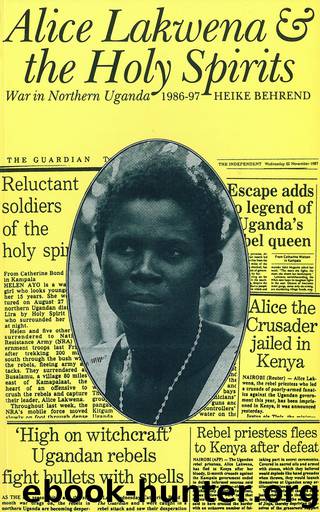Alice Lakwena and the Holy Spirits by Heike Behrend

Author:Heike Behrend [Behrend, Heike]
Language: eng
Format: epub
Publisher: Ohio University Press
Published: 1999-03-03T16:00:00+00:00
Seven
The History of Religions in Acholi
The separation of politics and religion in Europe developed in connection with the formation of the State and the Church as separate institutions. Since the colonial period, State and Church have been established as separate institutions in Uganda,1 but the dominant discourse, especially in the rural areas, remained bound up with religion. In religious discourses, especially in those conducted by spirits, the Acholi in northern Uganda – and not only they – gave expression to their more or less catastrophic experiences. The Holy Spirit Movement, too, is understandable only in the context of the history of the various religious discourses conducted in northern Uganda.
Since the discussion of pluralism (e.g. Fabian, 1985), it is no longer customary in monographs to have the ‘ethnographed’ speak with only a single voice. Instead, modern and postmodern ethnographies try to do justice to the variety of differing, often competing, discourses in a culture or cultural field. This chapter aims to provide a glimpse of the religious variety in northern Uganda. It will attempt to present the internal logic of alternative cults in synchronic and diachronic perspective. Only the depiction of the various cults and their transformations in opposition to each other can make the Holy Spirit Movement comprehensible in its differences from, but also in its similarities to, other cults.
At the beginning of the chapter, two events are described: a visit to an ajwaka, a pagan spirit medium; and a visit to a nebi, a Christian medium. Both mediums formed the centres of rival cults of affliction.2 Afterwards, the history of these cults is reconstructed in a diachronic perspective. Such a reconstruction seems to me to be absolutely necessary for the understanding of the Holy Spirit Movement, since the discourses and practices of the various successive cults, which were based on a logic of inversion, throw light on the discourse and practice of the Holy Spirit Movement.
A Visit to an Ajwaka
B. was a woman aged about fifty who lived with her husband and daughters in a sizeable homestead in Gulu Town. She also had another compound some miles outside Gulu, and here she conducted her seances in a round hut specially furnished for the purpose.
When B. was about ten years old, she went into the wilderness to eat wild fruit. There, a spirit took possession of her and gave her a small stool and cowry shells, the emblems of an ajwaka. She returned home, but before reaching home, she went ‘crazy’, she could not enter the house and had to sleep outdoors. She was taken to Ogwaro, a male ajwaka, who had healed her mother in the past. She went to a river and remained submerged for three hours. In the water, the spirit gave her a spear which actually belonged to Ogwaro, but which the spirit turned over to her. After that, he allowed her to sleep indoors again. The next morning, she found nine cowry shells and began divining with them. The spirit also taught her medicine, and she healed many people.
Download
This site does not store any files on its server. We only index and link to content provided by other sites. Please contact the content providers to delete copyright contents if any and email us, we'll remove relevant links or contents immediately.
The Lost Art of Listening by Michael P. Nichols(6672)
Why I Am Not A Calvinist by Dr. Peter S. Ruckman(3838)
The Rosicrucians by Christopher McIntosh(3129)
Wicca: a guide for the solitary practitioner by Scott Cunningham(2773)
Signature in the Cell: DNA and the Evidence for Intelligent Design by Stephen C. Meyer(2589)
Real Sex by Lauren F. Winner(2581)
The Holy Spirit by Billy Graham(2525)
To Light a Sacred Flame by Silver RavenWolf(2426)
The End of Faith by Sam Harris(2378)
The Gnostic Gospels by Pagels Elaine(2111)
Nine Parts of Desire by Geraldine Brooks(2063)
Waking Up by Sam Harris(2042)
Heavens on Earth by Michael Shermer(2008)
Devil, The by Almond Philip C(1977)
Jesus by Paul Johnson(1972)
The God delusion by Richard Dawkins(1930)
Kundalini by Gopi Krishna(1888)
Chosen by God by R. C. Sproul(1836)
The Nature of Consciousness by Rupert Spira(1753)
